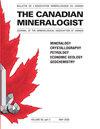Empirical Electronic Polarizabilities for Use in Refractive Index Measurements III. Structures with Short [5]Ti–O and Vanadyl Bonds
IF 1.5
4区 地球科学
Q3 MINERALOGY
引用次数: 1
Abstract
The electronic polarizabilities of most cations, such as Na+, Ca2+, Fe2+, Fe3+, and Zr4+, show a monotonic decrease as the cation coordination increases. However, polarizabilities of the ions [5]Ti4+, [5]V5+, and [6]V5+ show strong deviations from a regular decrease. In this paper we characterize the [5]Ti and vanadyl compounds by infrared frequencies, by the short [5]Ti4+– O, [5]V4+–O, [6]V4+–O, [5]V5+–O, and [6]V5+–O bonds and the polarizabilities of [5]Ti4+, [5]V4+, [6]V4+, [5]V5+, and [6]V5+ determined from refractive index measurements. Analysis of the structures of 18 compounds containing short [5]Ti–O bonds supports the concept of the short Ti–O bond being associated with the bond valence sum (omitting Ti) around the oxygen atom O*. The short Ti–O* bond occurs to satisfy the bond valence requirement of (O2–) of ∼2.0 vu. Plotting the [5]Ti–O* distances of 18 minerals versus the bond valence sum (BVS) around O* shows an approximately linear relationship. Extrapolation to BVS = 0 yields a minimum distance of 1.65 Å. The mean value is 1.693 Å. The mean short distances in V4+ vanadyl minerals are 1.597 Å (CN = 5) and 1.590 Å (CN = 6), whereas the mean short distance in five V5+ minerals is 1.647 Å (CN = 5) and in 14 V5+ minerals is 1.644 Å (CN = 6). We compare the polarizabilities of [5]Ti and [5,6]V4+ and [5,6]V5+ ions with the polarizabilities of [4]-coordinated Ti4+ ([4]Ti4+ ) and [6]-coordinated Ti4+ ([6]Ti4+ ) and of [4]-, [5]-, and [6]-coordinated V4+ and V5+ ([n]V4+ and [n]V5+) and hypothesize that the reduced polarizability of [5]Ti4+, [5]V5+, and [6]V5+ ions is caused by the short Ti–O* and V=O bonds.用于折射率测量的经验电子极化率3。具有短[5]Ti-O和钒基键的结构
随着阳离子配位的增加,Na+、Ca2+、Fe2+、Fe3+和Zr4+等阳离子的电子极化率呈单调下降趋势。然而,[5]Ti4+、[5]V5+和[6]V5+离子的极化率明显偏离规律下降。本文通过红外频率、[5]Ti4+ - O、[5]V4+ - O、[6]V4+ - O、[5]V5+ - O和[6]V5+ - O键和[5]Ti4+、[5]V4+、[6]V4+、[5]V5+和[6]V5+的折射率测量来表征[5]Ti和钒基化合物。对18个含有[5]短Ti - O键的化合物的结构分析支持了短Ti - O键与氧原子O*周围的键价和(省略Ti)有关的概念。短的Ti-O *键的出现是为了满足(O2 -)约2.0 vu的键价要求。18种矿物的[5]Ti-O *距离与O*附近的键价和(BVS)呈近似线性关系。外推到BVS = 0的最小距离为1.65 Å。平均值为1.693 Å。V4 + vanadyl矿物质的意思是短距离(CN = 5) 1.597和1.590 (CN = 6),而平均短的距离在5 V5 +矿物(CN = 5) 1.647 1.644和14 V5 +矿物(CN = 6)。我们比较[5]Ti的极化率和V4 +(5、6)和[5,6]V5 +离子的极化率[4]协调四价([4]四+)和[6]协调四价([6]四+)和[4],[5],和[6]-配位的V4+和V5+ ([n]V4+和[n]V5+),并假设[5]Ti4+、[5]V5+和[6]V5+离子的极化率降低是由短的Ti-O *和V=O键引起的。
本文章由计算机程序翻译,如有差异,请以英文原文为准。
求助全文
约1分钟内获得全文
求助全文
来源期刊

Canadian Mineralogist
地学-矿物学
CiteScore
2.20
自引率
22.20%
发文量
45
审稿时长
4-8 weeks
期刊介绍:
Since 1962, The Canadian Mineralogist has published papers dealing with all aspects of mineralogy, crystallography, petrology, economic geology, geochemistry, and applied mineralogy.
 求助内容:
求助内容: 应助结果提醒方式:
应助结果提醒方式:


